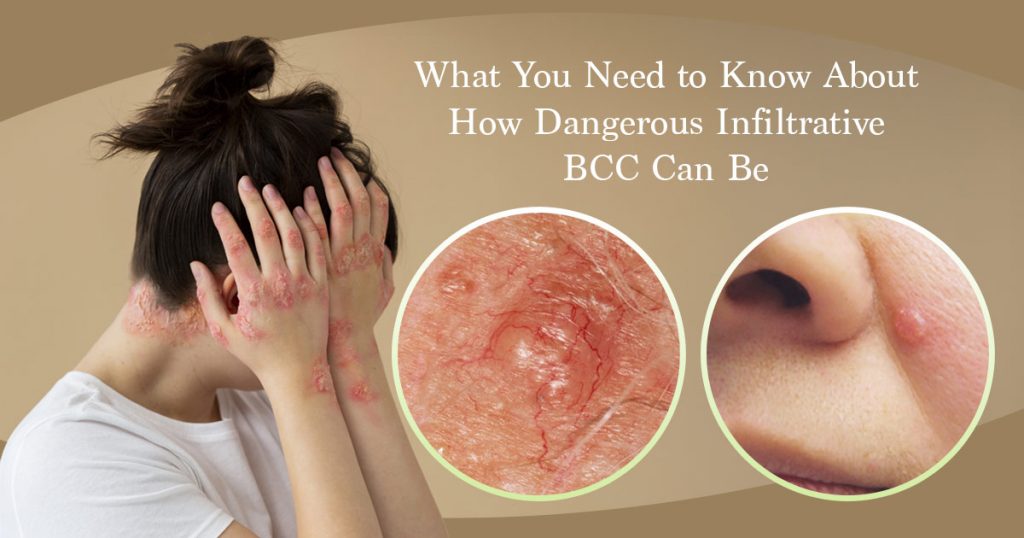Did you know that millions of people are diagnosed with skin cancer annually? And out of all those cases, basal cell carcinoma (BCC) is the most common type with 3.6 million diagnosed in the U.S. each year. While most forms of BCC are pretty manageable, one subtype you don’t hear about as often is infiltrative basal cell carcinoma. It’s trickier to treat and can cause serious problems if not caught early.
What is Infiltrative Basal Cell Carcinoma?
Okay, so first things first. Basal cell carcinoma happens when skin cells grow out of control, usually because of sun exposure. Most types, like nodular or superficial BCC, are easy to spot and treat. But infiltrative basal cell carcinoma likes to play hide-and-seek. It grows in thin, thread-like strands that can go deep into nearby tissue. This makes it harder to spot and even harder to remove entirely.
You might notice a patch of skin that looks a bit scar-like or feels hard and firm. Unlike the more common pearly bump people often associate with BCC, this kind isn’t as obvious. Because it can fly under the radar, it’s easy to delay treatment, which gives it more time to spread.
How Aggressive is It, Really?
Now, you might be wondering, “How bad can it be if it’s just skin cancer?” Well, the infiltrative type isn’t your typical slow-growing BCC. While it doesn’t usually travel to other parts of the body, like melanoma can, it gets a lot more personal by invading deeper layers of skin. If it’s near your nose, eyes, ears, or lips, it can cause functional and cosmetic issues because of how far it can spread locally.
For example, there was this one case where a patient ignored what looked like a harmless bump on their ear. Turns out it wasn’t harmless at all. By the time they sought help, the cancer had already spread into the cartilage, and surgeons had to work carefully to both remove the tumor and reconstruct the ear. That’s why catching it early makes such a huge difference.
What About Prognosis and Survival?
Here’s the good news. For most people, basal cell carcinoma, including the infiltrative type, isn’t life-threatening if treated. Studies show that the overall survival rate for basal cell carcinoma is incredibly high, over 90%. And rare as it is, death from basal cell carcinoma is almost unheard of.
That doesn’t mean you can ignore it, though. The longer you wait, the harder it becomes to treat. Advanced cases might require more invasive surgeries, leading to bigger scars or even loss of function, depending on where the cancer is located. That’s why early action isn’t just about staying healthy; it’s about preserving your quality of life.
How is It Treated?
Mohs Surgery
When it comes to infiltrative basal cell carcinoma, Mohs micrographic surgery is often the best treatment. Here’s how it works. The surgeon removes the skin cancer layer by layer, checking each one under a microscope until they’re sure every last cancer cell is gone. It’s super precise and has a cure rate of over 98%, which is music to anyone’s ears if they’ve been diagnosed.
Not only is it effective, but it’s also great for preserving as much healthy tissue as possible. This makes it ideal for spots where you really care about how you’re going to look, like your face.
Other Options
If Mohs surgery isn’t an option, there are other treatments. Doctors might recommend standard surgery, where they remove the cancer along with a small amount of surrounding tissue. Radiation therapy could also be helpful, especially if surgery isn’t a good idea health-wise.
For tougher cases that might have spread deeper, there are newer treatments like targeted drugs. One example is Hedgehog pathway inhibitors. They work by blocking certain signals that help cancer cells grow. And while you might hear about basal cell carcinoma laser treatments or photodynamic therapy, those are usually for less aggressive cases, not necessarily infiltrative types.
Preventing It in the First Place
All this talk about skin cancer might have you wondering how to avoid it entirely. The truth is, the best defense is a good offense. Protect your skin from UV rays, and you’re already lowering your risk.
Here are some simple tips to keep in mind:
- Use Sunscreen Every Day: SPF 30 or higher. Reapply if you’re outdoors for long periods.
- Cover Up: Wide-brimmed hats, sunglasses, and long-sleeved shirts are lifesavers, literally.
- Skip the Tanning Beds: Seriously, those things wreak havoc on your skin.
- Get Regular Skin Checks: If you’ve had skin cancer before, or notice anything odd, go see a dermatologist.
And remember, knowing what infiltrative basal cell carcinoma looks like is half the battle. If you see anything weird or discover a stubborn patch of skin that doesn’t heal, don’t wait around. Getting an expert’s opinion could spare you a lot of trouble later on.
Love Your Skin, Protect Your Future
Protecting your skin isn’t just about preventing skin cancer, although that’s a pretty compelling reason on its own. Taking care of your skin also helps reduce wrinkles, slows the visible effects of aging, and boosts your overall confidence in how you look and feel. When you make protecting your skin a priority with sunscreen, hats, and regular check-ups, you’re investing not just in your health but also in your long-term well-being and body image.
Remember, a little effort today can save you from a lot of trouble tomorrow. Your skin works hard to protect you, so it’s only fair to return the favor. Make the choice to care for it daily, and you’ll thank yourself down the line.
